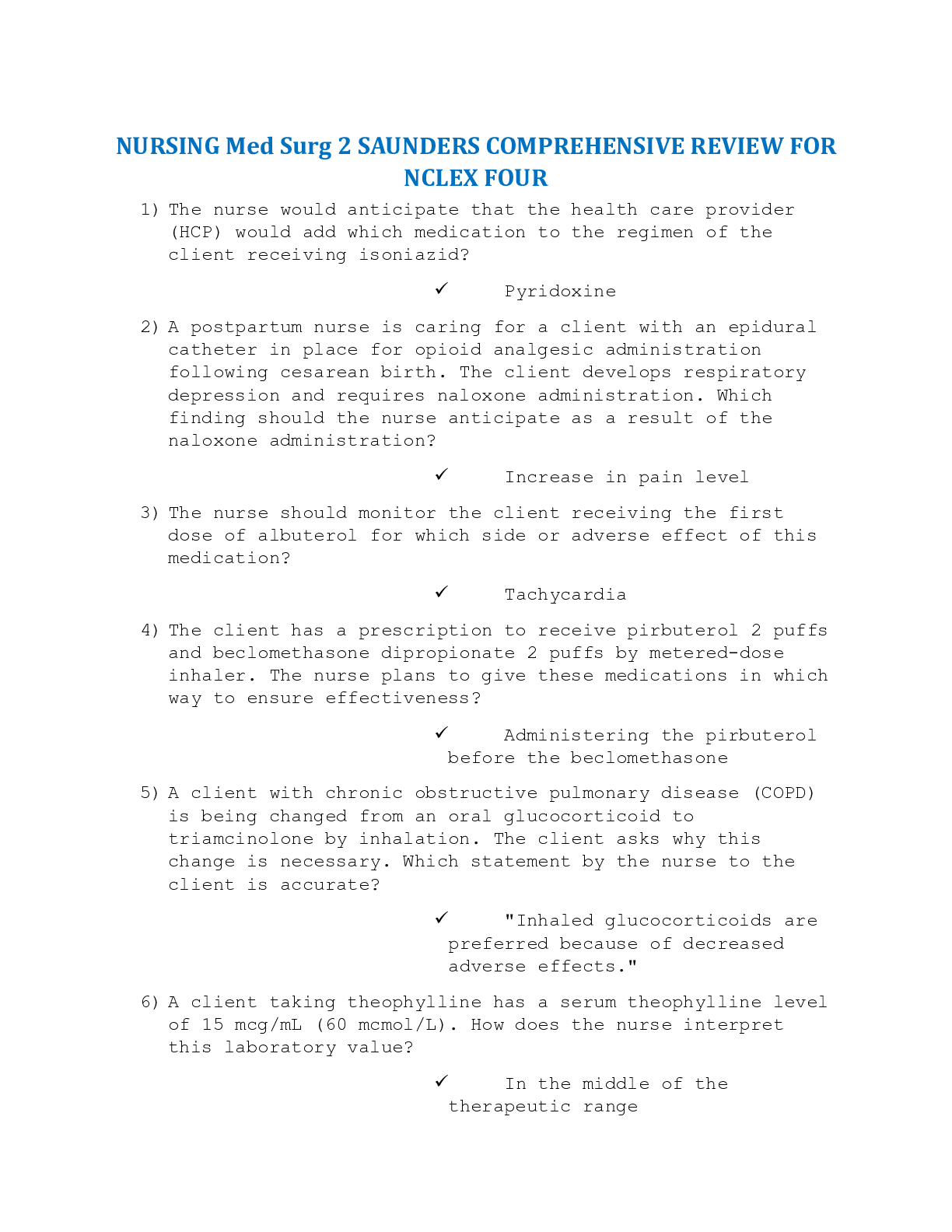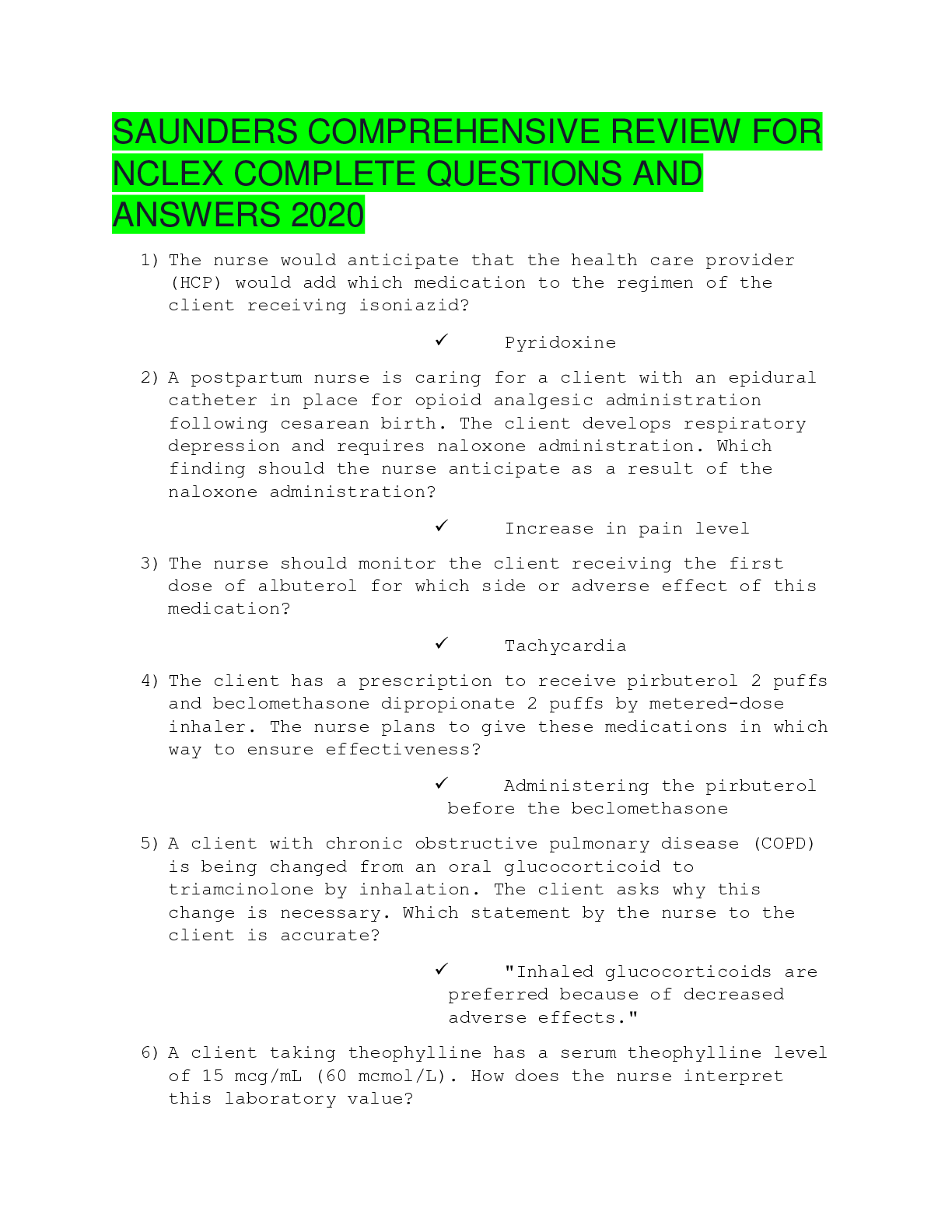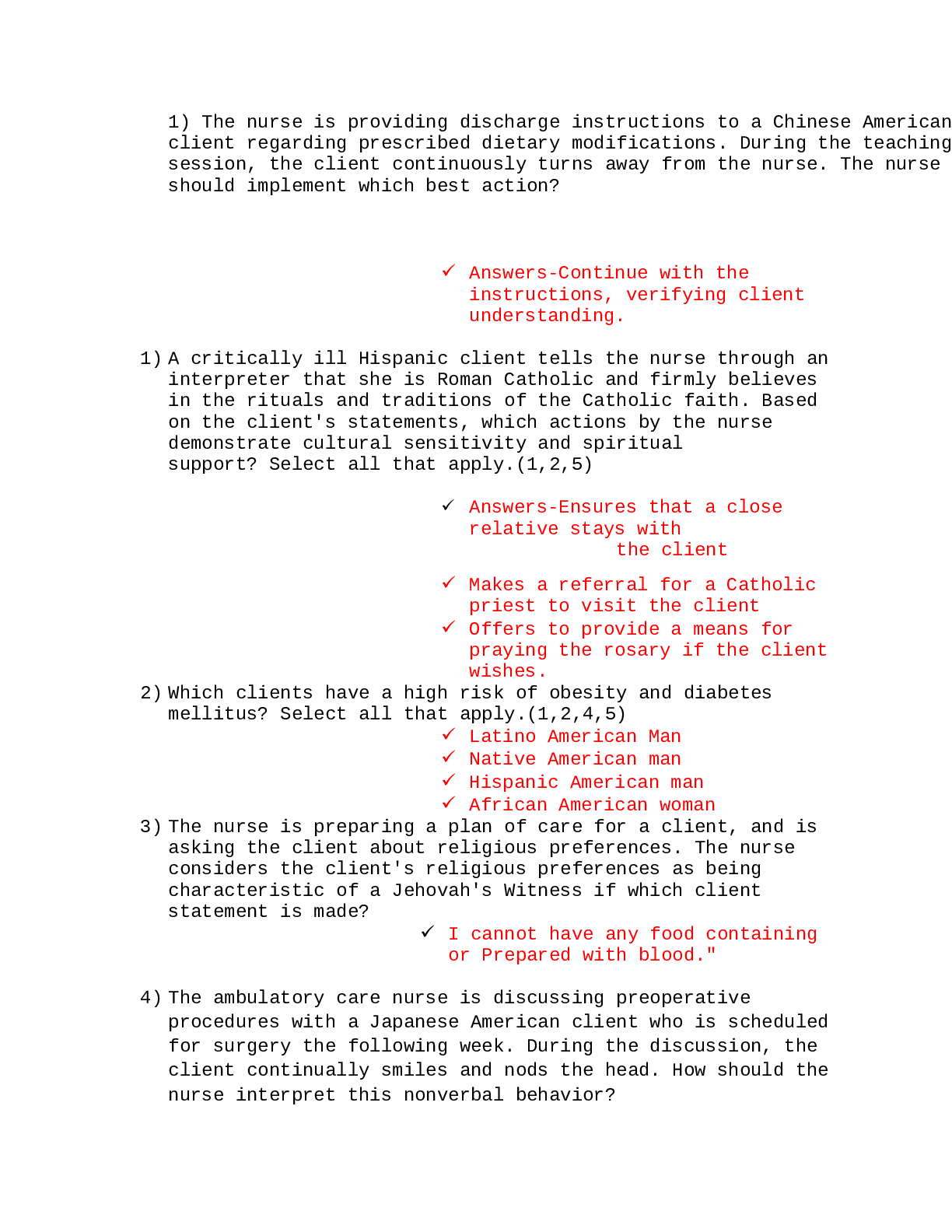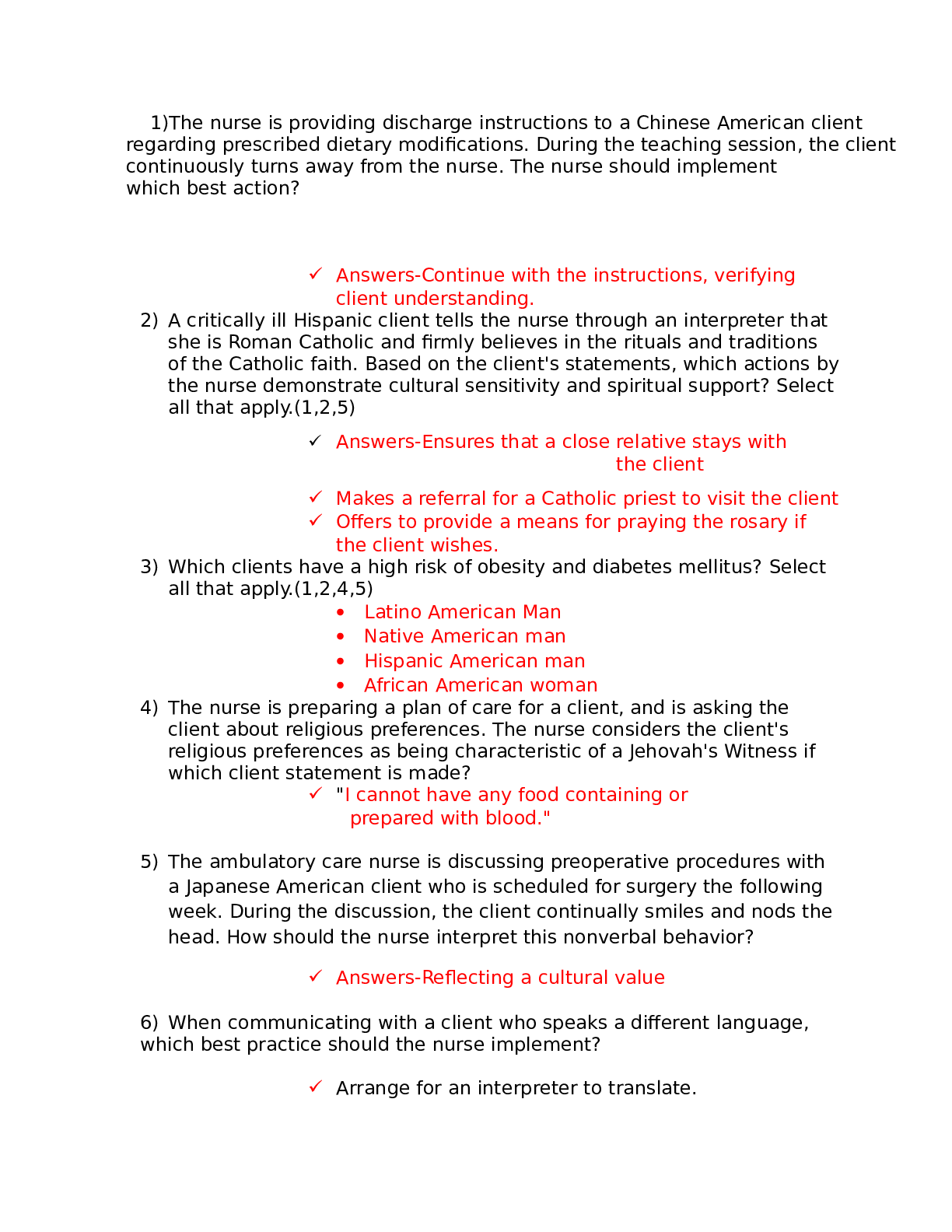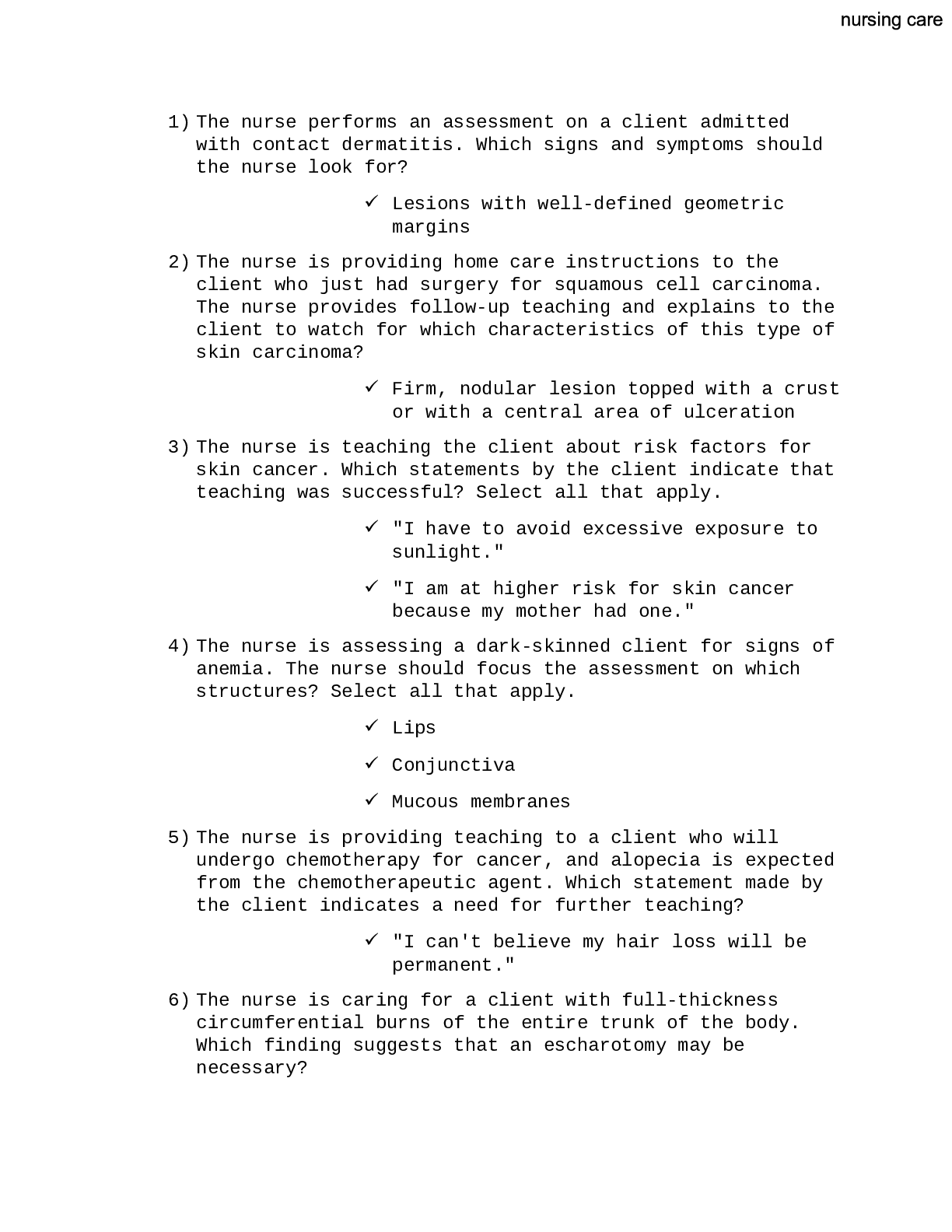SAUNDERS COMPREHENSIVE REVIEW FOR NCLEX 5
Document Content and Description Below
SAUNDERS COMPREHENSIVE REVIEW FOR NCLEX 5 1) A child with an autism spectrum disorder (ASD) is being admitted to the hospital for diagnostic tests. Which room assignment is the most appropriate for... the child? Private room 2) The labor and delivery room nurse has just received reports on 4 clients. After reviewing the client data, the nurse should assess which client first? A client who has just received an intravenous loading dose of magnesium sulfate to stop preterm labor 3) The nurse has developed a teaching plan for a client with hypertension regarding the administration of prescribed medications. What is the initial nursing action? Assess the client's readiness to learn. 4) A client with cancer is receiving intravenous morphine sulfate for pain. When writing the plan of care for this client, the nurse should include which action as the priority action? Monitor respiratory status. 5) The nurse is preparing to suction the airway of a client who has a tracheostomy tube and gathers the supplies needed for the procedure. In order of priority, which actions should the nurse take to perform this procedure? Arrange the actions in the order that they should be performed. All options must be used. 1) Place the client in a semi Fowler's position. 2) Turn on the suction device and set the regulator at 80 mm Hg. 3) Attach the suction tubing to the suction catheter. 4) Hyperoxygenate the client. 5) Insert the catheter into the tracheostomy until resistance is met, and then pull it back 1 cm. 6) Apply intermittent suction and slowly withdraw the catheter while rotating it back and forth. 6) The nurse notes blanching, coolness, and edema at a client's peripheral intravenous (IV) site. Which nursing action is the priority? Remove the IV catheter. 7) A client has a prescription to begin an infusion of 1000 mL of 5% dextrose in lactated Ringer's solution. The client has an intravenous (IV) cannula inserted, and the nurse prepares the solution and IV tubing. Arrange the actions in the order that they should be performed. All options must be used. 1) Close the roller clamp on the IV tubing. 2) Spike the IV bag and half-fill the drip chamber. 3) Open the roller clamp and fill the tubing. 4) Uncap the distal end of the tubing. 5) Attach the distal end of the tubing to the client. 8) The nurse is caring for 4 pediatric clients. After receiving reports from the night shift, which child should the nurse assess first? A 6-week-old infant admitted to the hospital for decreased level of consciousness; shaken baby syndrome is suspected 9) The nurse is assigned to 4 clients on a postoperative surgical unit at a rural hospital. When prioritizing the care, the nurse recognizes that the highest priority is focused on which client? The client with problems clearing the airway related to abdominal incision pain 10) The emergency department nurse is caring for a child with suspected epiglottitis and has ensured that the child has a patent airway. Which action is the next priority in the care of this child? Prepare the child for a chest radiograph. 11) The nursing instructor asks the nursing student to identify the priorities of care for an assigned client. The nursing instructor determines that the nursing student understands the client's needs when which statement is made? "Actual or life-threatening concerns are the priority." 12) A hospitalized client with type 1 diabetes mellitus received Humulin N and Humulin R insulin 2 hours ago (at 7:30 a.m.). The client calls the nurse and reports that he is feeling hungry, shaky, and weak. The client ate breakfast at 8 a.m. and is due to eat lunch at noon. Arrange the actions that the nurse will take in the order that they should be performed. All options must be used. 1) Check the client's blood glucose level. 2) Give the client ½ cup (118 mL) of fruit juice to drink. 3) Take the client's vital signs. 4) Retest the blood glucose level. 5) Give the client a small snack of carbohydrate and protein. 6) Document the client's complaints, actions taken, and outcome. 13) An emergency department nurse is preparing to receive 4 clients as a result of a motor vehicle crash. Which victim should the nurse attend to first? A 45-year-old man with chest pain, shortness of breath, and diaphoresis 14) The nurse is assigned to care for 4 clients. Which client should the nurse assess first? A client who has a peripheral (index finger) oxygen saturation percentage of 85% 15) The nurse has received her client assignment for the day. Which client should the nurse care for first? A client with postoperative pain reported at 7 out of 10, with 10 being the worst 16) The nurse has received the client assignment for the day. Which client should the nurse care for first? The client admitted with the medical diagnosis of neutropenia who is afebrile and is complaining of pain with urination 17) The nurse is the first responder at the scene of a 6-car crash on a highway. Which victim should the nurse attend to first? A victim experiencing dyspnea 18) The nurse in charge of a nursing unit is asked to select the hospitalized clients who can be discharged so that hospital beds can be made available for victims of a community disaster. Which clients can be safely discharged? Select all that apply. A client with a Holter monitor A client receiving oral antibiotics A client experiencing sinus rhythm 19) The nurse has received her client assignment for the day. Which client should the nurse check first? A client who has just returned from surgery 20) The nurse is a responder at the scene of a building collapse. Which victim should the nurse care for first? Victim with an apparent chest wall defect and asymmetrical chest wall movement 21) The nurse manager of a medical-surgical unit is asked to select the hospitalized clients who can be discharged so that hospital beds can be made available for victims of a community disaster. Which clients can be safely discharged? Select all that apply. Client postoperative day 1 after inguinal herniorrhaphy, vital signs stable Client 5 days after a myocardial infarction, vital signs stable, absence of dysrhythmias Client 1 day after cardiac catheterization, normal study results, groin site free of hematoma 22) The nurse is the first responder at the scene of an accident in which a tire blowout caused a bus to roll over several times. Which victim should the nurse attend to first? The confused 12-year-old with bright red blood pulsing from an open fracture of the femur 23) The nurse in charge of a nursing unit is asked to select those hospitalized clients who can be discharged so that hospital beds can be made available for victims of a community disaster. Which clients can be safely discharged? Select all that apply. The client who 24 hours earlier gave birth to her second child by caesarean delivery The 48-hour postoperative client who has undergone an ileostomy because of ulcerative colitis The 2-day postoperative client who has undergone total knee replacement and is ambulating with a walker The 3-day postoperative client who has undergone coronary artery bypass grafting and is ready for rehabilitation 24) The nurse has received her client assignment for the day. Which client should the nurse care for first? The 53-year-old client with heart failure who has gained 4 pounds (1.8 kg) since yesterday and is short of breath 25) During morning report, the day nurse is given information on the assigned clients. Which client should the nurse assess first? The 60-year-old client with leukemia who is receiving the first round of chemotherapy, which was started at 0630 and is scheduled to end at noon 26) The nurse determines that which client has the highest priority needs? The client who has an irregular apical pulse of 120 beats per minute 27) When planning care, which client should the nurse assess first? The client with a chest tube for a pneumothorax 28) The nurse assigned to 4 clients reviews client data at the beginning of the shift. To which information should the nurse give highest priority? Pulse oximetry reading 89% 29) A home health care nurse is planning client visits and nursing activities for the day. The nurse begins the visits at 9 a.m. All clients live within a 5-mile radius. In order of priority, how the nurse should plan the assignments for the day? Arrange the actions in the order that they should be performed. All options must be used. 1) A client with diabetes mellitus who needs a fasting blood glucose level drawn 2) The first dressing change for a client requiring twice-daily dressing changes 3) A client being visited by the home health aide at 1030 4) A client requiring supervision of a dressing change 5) A client requiring an admission assessment to home health care 6) The second dressing change for a client requiring twice-daily dressing changes 30) The nurse is monitoring a client receiving total parenteral nutrition (TPN). The client suddenly develops respiratory distress, dyspnea, and chest pain, and the nurse suspects air embolism. In order of priority, how should the nurse plan the actions to take? Arrange the actions in the order that they should be performed. All options must be used. 1) Clamp the intravenous (IV) catheter. 2) Position the client in a left Trendelenburg's position. 3) Contact the health care provider (HCP). 4) Administer oxygen. 5) Take the client's vital signs. 6) Document the occurrence. 31) A unit of packed red blood cells has been prescribed for a client with low hemoglobin and hematocrit typing and crossmatching. The nurse receives a telephone call from the blood bank and is informed that the unit of blood is ready for administration. In order of priority, how should the nurse plan the actions to take? Arrange the actions in the order that they should be performed. All options must be used. 1) Verify the health care provider's (HCP's) prescription for the blood transfusion. 2) Ensure that an informed consent has been signed. 3) Insert an 18- or 19-gauge intravenous catheter into the client. 4) Obtain the unit of blood from the blood bank. 5) Ask a licensed nurse to assist in confirming vital signs and blood compatibility and verifying client identity. 6) Hang the bag of blood. 32) The nurse is monitoring a client in labor who is receiving oxytocin and notes that the client is experiencing hypertonic uterine contractions. In order of priority, how should the nurse plan the actions to take? Arrange the actions in the order that they should be performed. All options must be used. 1) Stop the oxytocin infusion. 2) Reposition the client. 3) Administer oxygen by face mask at 8 to 10 L/min. 4) Perform a vaginal examination. 5) Check the client's blood pressure. 6) Administer medication as prescribed to reduce uterine activity. ..........Continued [Show More]
Last updated: 1 year ago
Preview 1 out of 186 pages
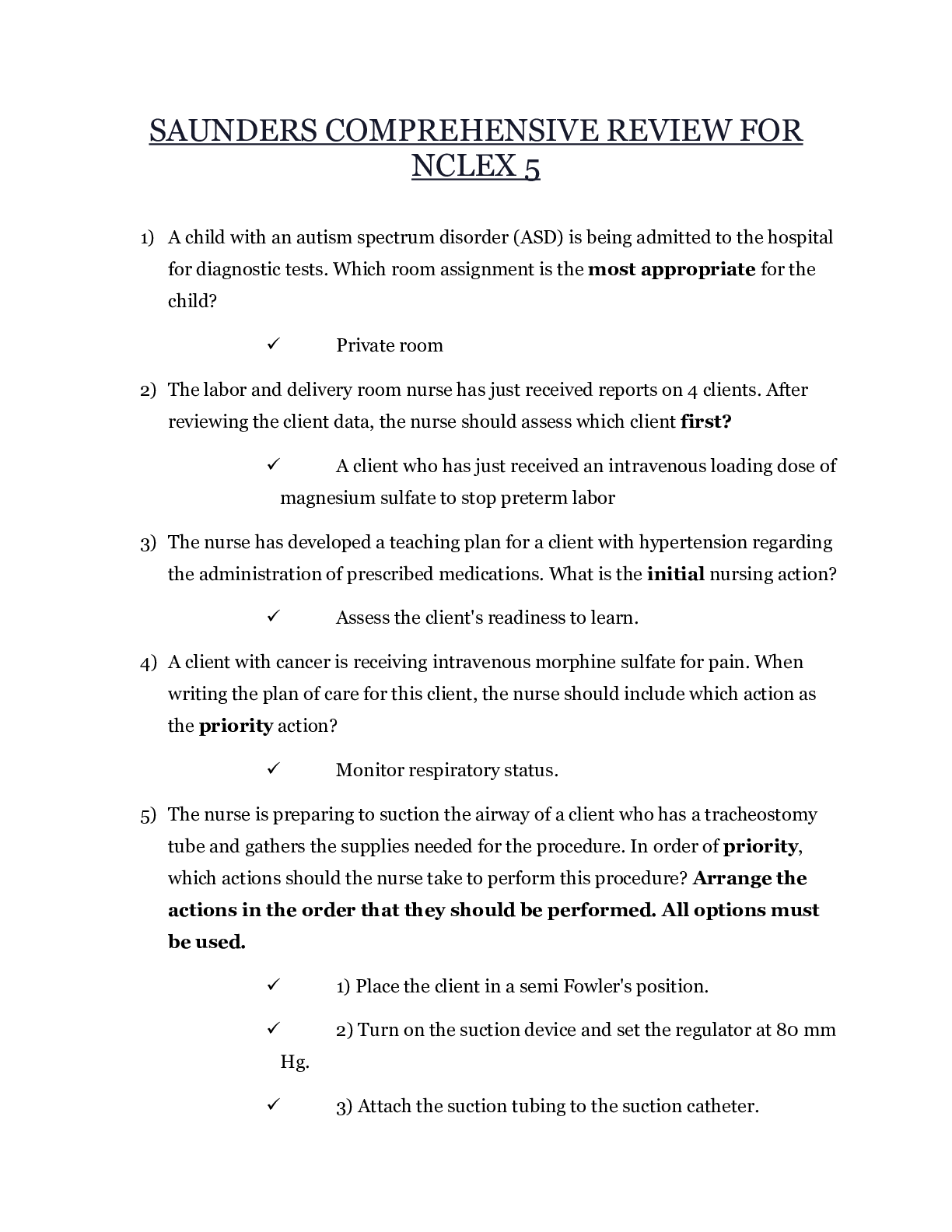
Buy this document to get the full access instantly
Instant Download Access after purchase
Add to cartInstant download
We Accept:

Reviews( 0 )
$23.50
Document information
Connected school, study & course
About the document
Uploaded On
Feb 10, 2021
Number of pages
186
Written in
Additional information
This document has been written for:
Uploaded
Feb 10, 2021
Downloads
0
Views
65


